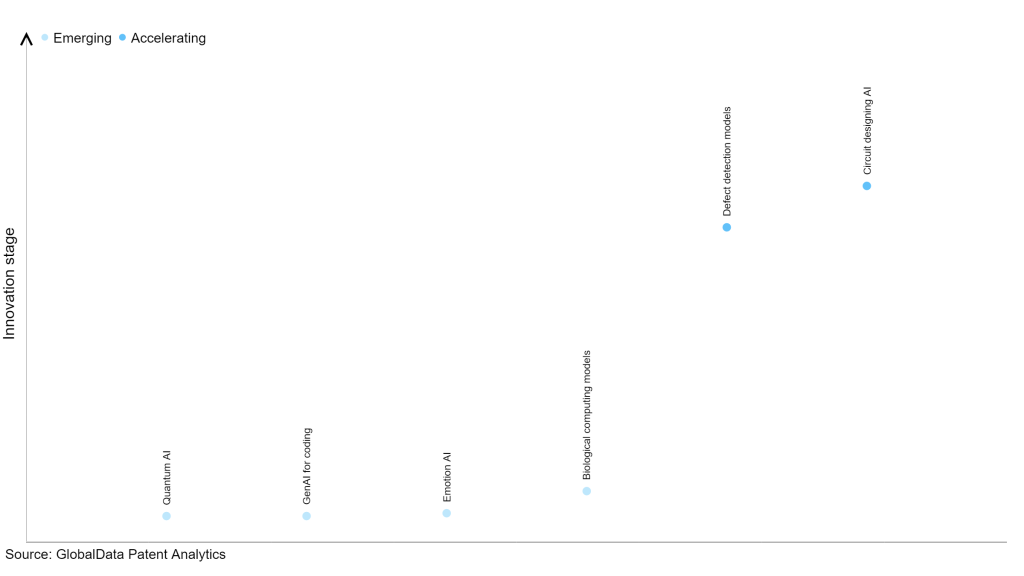The technology industry continues to be a hotbed of patent innovation. Activity is driven by the rapid emergence and widespread adoption of game-changing technologies such as artificial intelligence (AI), machine learning, computer vision and natural language processing, and growing importance of technologies such as sentiment analysis, facial expression recognition, speech and voice recognition, and biometric sensors. Emotion AI is used in virtual agents and chatbots to create more engaging and empathetic interactions with users. In the last three years alone, there have been over 1.5 million patents filed and granted in the technology industry, according to GlobalData’s report on Artificial intelligence in technology: emotion AI. Buy the report here.

Access deeper industry intelligence
Experience unmatched clarity with a single platform that combines unique data, AI, and human expertise.
However, not all innovations are equal and nor do they follow a constant upward trend. Instead, their evolution takes the form of an S-shaped curve that reflects their typical lifecycle from early emergence to accelerating adoption, before finally stabilizing and reaching maturity.
Identifying where a particular innovation is on this journey, especially those that are in the emerging and accelerating stages, is essential for understanding their current level of adoption and the likely future trajectory and impact they will have.
185+ innovations will shape the technology industry
According to GlobalData’s Technology Foresights, which plots the S-curve for the technology industry using innovation intensity models built on over 1.6 million patents, there are 185+ innovation areas that will shape the future of the industry.
Within the emerging innovation stage, quantum AI, GenAI for coding and emotion AI are disruptive technologies that are in the early stages of application and should be tracked closely. Biological computing models, defect detection models, and circuit designing AI are some of the accelerating innovation areas, where adoption has been steadily increasing.
Innovation S-curve for artificial intelligence in the technology industry

Emotion AI is a key innovation area in artificial intelligence
Emotion AI refers to an AI technology specifically developed to analyse and identify human emotions. It finds applications across a wide range of uses, including customer service chatbots and facial recognition tools. By leveraging natural language processing, machine learning, and computer vision methods, it can accurately detect and interpret human facial expressions, vocal tones, and text-based interactions.
GlobalData’s analysis also uncovers the companies at the forefront of each innovation area and assesses the potential reach and impact of their patenting activity across different applications and geographies. According to GlobalData, there are 280+ companies, spanning technology vendors, established technology companies, and up-and-coming start-ups engaged in the development and application of emotion AI.
Key players in emotion AI – a disruptive innovation in the technology industry
‘Application diversity’ measures the number of applications identified for each patent. It broadly splits companies into either ‘niche’ or ‘diversified’ innovators.
‘Geographic reach’ refers to the number of countries each patent is registered in. It reflects the breadth of geographic application intended, ranging from ‘global’ to ‘local’.
Samsung Group is the leading patent filer in emotion AI, followed by International Business Machines (IBM) and Sony Group. Other prominent patent filers in the space include Microsoft, LG, Baidu, and NEC.
By geographic reach, Observe Technologies leads the pack, followed by Drishti Technologies and eBay. In terms of application diversity, Snap holds the top position, followed by LG and Sony Group.
Emotion AI enables more empathetic and personalized interactions between humans and AI systems. By understanding and responding to human emotions, emotion AI enhances user experiences, improves customer service, and opens opportunities for applications in mental health, education, and various other domains.
To further understand how artificial intelligence is disrupting the technology industry, access GlobalData’s latest thematic research report on Artificial Intelligence (AI).
Data Insights
From

The gold standard of business intelligence.
Blending expert knowledge with cutting-edge technology, GlobalData’s unrivalled proprietary data will enable you to decode what’s happening in your market. You can make better informed decisions and gain a future-proof advantage over your competitors.







